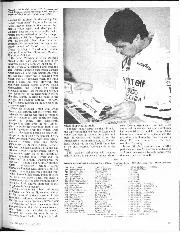Some time later I mentioned that to Ayrton, and he was much gratified by the comparison with Gilles. “I wasn’t always ahead of the car, though,” he said. “The conditions were so bad that corners were changing, lap to lap, and sometimes the car was driving me…”
Race day morning in Estoril was dry, as practice had been, but by the time of the warm-up the clouds were blackening, and light rain came in at noon. By 1.30 it was pouring down.
Alongside Senna on the front row was Prost’s McLaren, with Keke Rosberg’s Williams and Ayrton’s team-mate, Elio de Angelis, on row two, then Michele Alboreto’s Ferrari and Derek Warwick’s Renault on row three.
After qualifying, Prost, although four tenths slower than Senna, had felt optimistic about his chances. “I didn’t run a lot of boost in qualifying – not much more than we use in the race, actually – so I wasn’t too quick in the straight, but we have a very good set-up for the race.” Sunday’s monsoon put Alain – and everyone else – back to square one, however, and now set-up was a matter of guesswork.
In the modern era conditions such as those at Estoril would inevitably mean a start behind the safety car, then umpteen laps cruising around until it was deemed acceptable to go racing, but back then the safety car hadn’t so much as been thought of. The light went from red to green, and away they went.

Senna leads from pole in Estoril
DPPI
After one lap the Lotuses came through 1-2, followed by Prost, Alboreto and Warwick, but if Senna was treading warily, he was doing it way faster than anyone else, capitalising on clear vision as well as his unearthly car control. At the end of the second lap he was three seconds up on de Angelis.
In the spray and murk behind Ayrton, others were having a terrible time, notably Piquet, whose Brabham started in the top 10, but swiftly had a queue forming up behind it.
Even during dry practice Nelson had not been happy: “The track is very dirty off line, and it doesn’t seem to have gained much grip this time – not like last year. Then again, I was on Michelins last year…”
Ah, yes. When Michelin pulled out of F1, at the end of 1984, two of its teams – McLaren and Renault – went with Goodyear, the other two – Brabham and Ligier – with Pirelli. In the wet the difference between the two was even starker: after 16 laps Jacques Laffite parked his Ligier, saying the car was undriveable, the conditions unacceptable, and although Piquet plugged on, making innumerable pit stops – during one of which he alighted from the car, and changed into dry overalls! – eventually he, too, called it a day. “In the car I was cursing Ecclestone,” he said, “for taking Pirelli’s money…”





